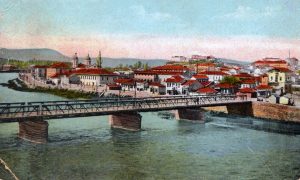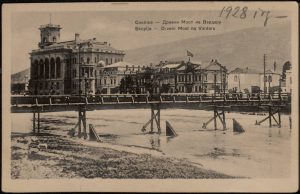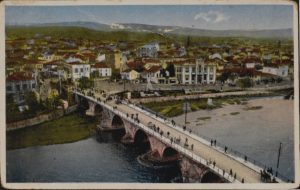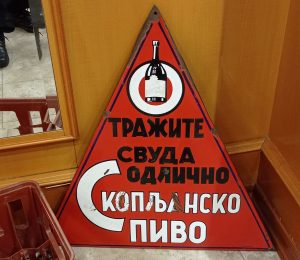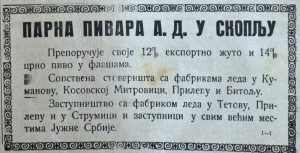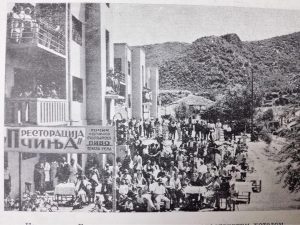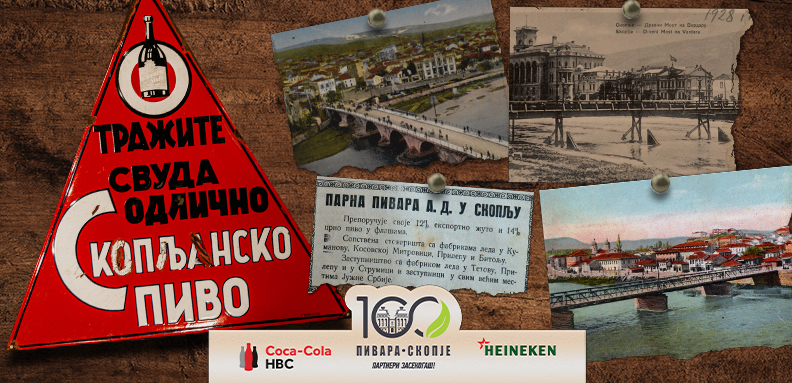
THE EARLY BEGINNINGS OF SKOPSKO’S ADVERTISING CAMPAIGN
Poured by:
Vasilka Dimitrovska, M.Sc
Alexander Madzovski
HAEMUS – Center for scientific research and promotion of culture
Since its earliest beginnings, Pivara Skopje has tried to inform its consumers aesthetically and attractively, building on the very quality of SKOPSKO beer. We are reconstructing the timeline and details based on several archival findings and one significant artifact for us.
On June 2, 1931, the then Parna Pivara requested permission from the Municipal Court of the City of Skopje to install “quality-made metal plates” in several strategically selected places in and around the city. What makes an impression are the carefully chosen words in this request. The petitioner pointed out that the plates will be of high quality and thus will not aesthetically disturb the face of the city. This document also gives us some idea of which were the busiest places in Skopje at that time. According to the petition, the panels were to be placed in the following locations:
a) at the entrances to Skopje next to the excise stations (the then tolls) namely:
– at the Kumanovo pay toll, which was located near today’s “Kontinental” hotel and the “Galeb” cafe;
– on the Tetovo pay toll, which was located near today’s intersection between the American Embassy and today’s “Ilinden” barracks;
b) on the way to the airport;
c) on the road to Vodno;
d) on both sides of the then main Skopje bridges:
– The Iron bridge, the remains of which can still be seen today on Vardar near “East Gate Mall”;
– The Stone bridge and
– The Wooden bridge, which was located between the Stone Bridge and today’s “Goce Delchev” bridge, connecting the old Jewish Quarter with the rest of Skopje;
Figure 1-3: View from the Iron, Wooden and Stone bridges in the city of Skopje
– in front of the main and small railway stations;
– at the music pavilion on the corner between the streets “Kral Petar” (today’s “Macedonia” street) and the parallel “Prince George” which connected the railway station with the square.
On July 11, 1931 the necessary permission was issued and the advertisements were placed.
The artifact we mentioned is just such a sheet metal advertising panel, which was found in Leskovac, Serbia. The place where it was found leaves the possibility to assume that SKOPSKO was advertised in other cities as well, not only in Skopje and its surroundings. In addition, the illustration on the panel gives us an idea of what the Skopje beer bottles and labels looked like at the time.
Figure 4: Tin advertising panel of Pivara Skopje from the 1930s, found in Vranje (Serbia).
Somewhere in that period, the increasingly frequent advertisements for beer in newspapers began, such as the example of the newspaper “Vardar”, which was published in the period between the two world wars in Skopje. The advertisements themselves are a valuable source of information. From them we learn that in that period Parna Pivara AD produced two types of beer: white (sometimes also found as yellow) with twelve percent malt extract and black with fourteen percent malt extract. These two classifications correspond to today’s light and dark beer. In addition, the advertisements also list the brewery’s most important products. In addition to the main warehouse in Skopje, the other warehouses were in: Bitola, Prilep, Kumanovo and Kosovska Mitrovica.
Figure 5: Excerpt from the newspaper “Vreme” with an advertisement for Parna Pivara AD Skopje
During that period, advertisements for another medium, which will soon win loyal followers all over the world, began to appear more and more in newspapers as a printed medium. It was — the radio. Taking into account the economic conditions, homes that owned radio devices were rare, but it is not at all excluded that from time to time an advertisement for the quality of SKOPSKO was broadcast over the radio waves.
Figure 6: Advertisement for SKOPSKO, placed near Katlanovska Banja
The text is adapted and reworked from the original scientific research project of HAEMUS entitled “Study on the history of Parnata Pivara Skopje”, commissioned and supported by Pivara Skopje.
Photo: Archives of Pivara Skopje, private collectors
Archival sources: NUB “St. Kliment Ohridski” – Skopje, DARMS – department Skopje (Archive of the City of Skopje), Archive of the Skopje Brewery







